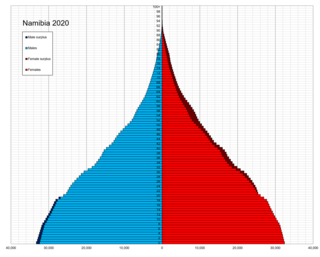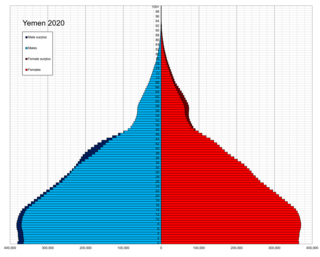Related Research Articles

This article is a demography of the population of Antigua and Barbuda including population density, ethnicity, religious affiliations and other aspects of the population.

Demographic features of the population of Botswana include population density, ethnicity, education level, health of the populace, economic status, religious affiliations and other aspects.

The demographic profile of Cameroon is complex for a country of its population. Cameroon comprises an estimated 250 distinct ethnic groups, which may be formed into five large regional-cultural divisions:

The Demographics of Gabon is the makeup of the population of Gabon. As of 2020, Gabon has a population of 2,225,287. Gabon's population is relatively young with 35.5% of its population under 15 years of age and only 4.3% of its population over 65 years old. Gabon has a nearly even split between males and females with 0.99 males for every female in the population. In the age range of 15–65, the ration is exactly 1 male to 1 female. The life expectancy of Gabon is lower than the world average. Gabon's population's life expectancy at birth is 53.11 years while the world average is 67.2 years as of 2010. Ethnically, the biggest group in Gabon are the Fang people with over 500,000 people, or about a third of Gabon's population, belonging to this ethnic group. The biggest religion in Gabon is Christianity, with between 55–75% of the population of Gabon being Christian.

The demography of the people of Grenada, Grenadians, includes population density, ethnicity, education level, health of the populace, economic status, religious affiliations and other aspects of the population.

India is the most populous country in the world with one-sixth of the world's population. According to estimates from the United Nations (UN), India has overtaken China as the country with the largest population in the world, with a population of 1,425,775,850 at the end of April 2023.

The population of Indonesia was 270.20 million according to the 2020 national census, an increase from 237.64 million in 2010. The official estimate as at mid 2022 was 275,773,800, increasing at a rate of 1.17% per year. Indonesia is the fourth most populous country in the world. Approximately 55% of Indonesia's population resides on Java, which is the most populous island in the world.

The Iraqi people are people originating from the country of Iraq.

Demographic features of the population of Lesotho include population density, ethnicity, education level, health of the populace, economic status, religious affiliations and other aspects.
This is a demography of the population of Monaco, including population density, ethnicity, education level, health of the populace, economic status, religious affiliations and other aspects of the population.

This is a demography of the population of Namibia including population density, ethnicity, education level, health of the populace, economic status, religious affiliations and other aspects of the population.

Demographic features of the population of Eswatini include population density, ethnicity, education level, health of the populace, economic status, religious affiliations and other aspects of the population.

Demographic features of the United Arab Emirates (UAE) include population density, vital statistics, immigration and emigration data, ethnicity, education levels, religions practiced, and languages spoken within the UAE.

Demographic features of the population of Yemen include population density, ethnicity, education level, health of the populace, economic status, religious affiliations and other aspects of the population.

Demographic features of the population of Zimbabwe include population density, ethnicity, education level, health of the populace, economic status, religious affiliations and other aspects of the population.

This is a demography of the population of Azerbaijan including population density, ethnicity, education level, health of the populace, economic status, religious affiliations and other aspects of the population.

The demographics of the population of Bahrain includes population density, ethnicity, education level, health of the populace, economic status, religious affiliations and other aspects of the population.

This is a demography of the population of Bhutan including population density, ethnicity, education level, health of the populace, economic status, religious affiliations and other aspects of the population.

Demographic features of the population of the area commonly described as Palestinian territories includes information on ethnicity, education level, health of the populace, economic status, religious affiliations and other aspects of that population.
References
- 1 2 3 "National Population Census Report 2001 - Montserrat" (PDF). Archived from the original (PDF) on 2016-03-31. Retrieved 2014-01-01.
- ↑ "CARICOM Statistics" (PDF). Archived from the original (PDF) on 2014-07-14. Retrieved 2014-06-07.
- ↑ "Montserrat Population (2023) - Worldometer". www.worldometers.info.
- ↑ "Montserrat population (2023) live — Countrymeters". countrymeters.info.
- ↑ The National Cyclopaedia of Useful Knowledge, Vol.IV. London: Charles Knight. 1848. p. 772.
- ↑ "Montserrat evacuation remembered". 2005-09-12. Retrieved 2021-06-28.
- ↑ "World Population Prospects - Population Division - United Nations". population.un.org.
- ↑ "Country-of-birth database". Organisation for Economic Co-operation and Development. Archived from the original on 2009-06-17. Retrieved 2008-09-20.
- ↑ United Nations. Demographic Yearbooks
- ↑ "Archived copy" (PDF). Archived from the original (PDF) on 2016-03-25. Retrieved 2016-03-17.
{{cite web}}: CS1 maint: archived copy as title (link) - ↑ "Social and Demographic Statistics". Statistics Department Montserrat. Retrieved 2024-05-20.
- 1 2 "UNSD — Demographic and Social Statistics". unstats.un.org. Retrieved 2023-05-10.
- ↑ "Life expectancy at birth - The World Factbook". www.cia.gov. Retrieved 2024-04-03.
- ↑ "List of Countries by Life Expectancy 2023 | life —— lines". 2024-01-22. Retrieved 2024-04-03.
- 1 2 "Central America and Caribbean :MONTSERRAT". CIA The World Factbook. 22 September 2021.